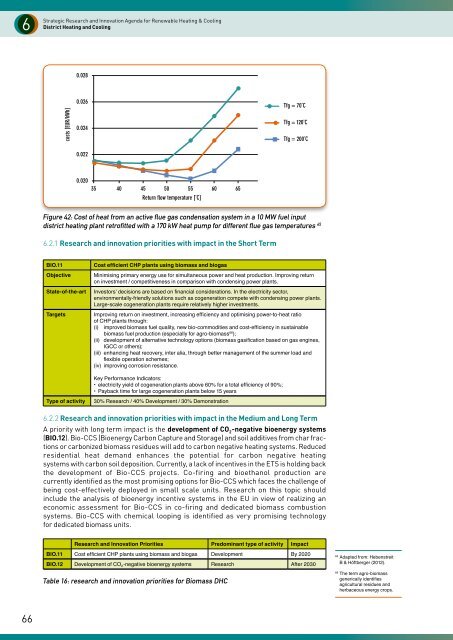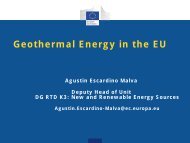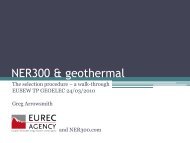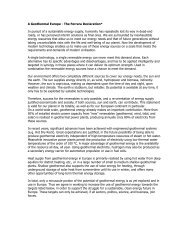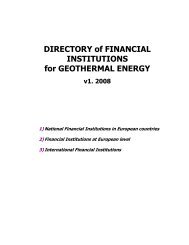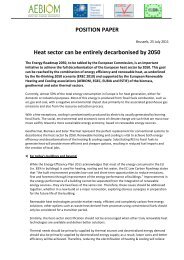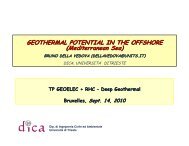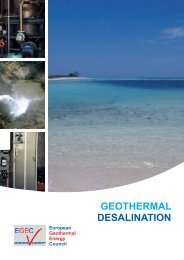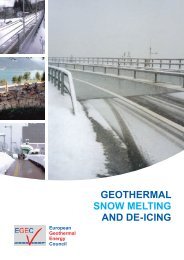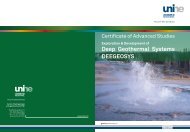Strategic Research and Innovation Agenda for Renewable ... - EGEC
Strategic Research and Innovation Agenda for Renewable ... - EGEC
Strategic Research and Innovation Agenda for Renewable ... - EGEC
Create successful ePaper yourself
Turn your PDF publications into a flip-book with our unique Google optimized e-Paper software.
602000 2020 2050<strong>Strategic</strong> <strong>Research</strong> <strong>and</strong> <strong>Innovation</strong> <strong>Agenda</strong> <strong>for</strong> <strong>Renewable</strong> Heating & CoolingDistrict Heating <strong>and</strong> Cooling0%Solar DH0.028Geothermal DHBiomass DHDC - Abs. Chillerscosts [EUR/kWh]0.0260.024Tfg = 70˚CTfg = 120˚CTfg = 200˚C0.0220.02035 40 45 50 55 60 65Return flow temperature [˚C]Figure 42: Cost of heat from an active flue gas condensation system in a 10 MW fuel inputdistrict heating plant retrofitted with a 170 kW heat pump <strong>for</strong> different flue gas temperatures 656.2.1 <strong>Research</strong> <strong>and</strong> innovation priorities with impact in the Short TermBIO.11ObjectiveState-of-the-artTargetsCost efficient CHP plants using biomass <strong>and</strong> biogasMinimising primary energy use <strong>for</strong> simultaneous power <strong>and</strong> heat production. Improving returnon investment / competitiveness in comparison with condensing power plants.Investors’ decisions are based on financial considerations. In the electricity sector,environmentally-friendly solutions such as cogeneration compete with condensing power plants.Large-scale cogeneration plants require relatively higher investments.Improving return on investment, increasing efficiency <strong>and</strong> optimising power-to-heat ratioof CHP plants through:(i) improved biomass fuel quality, new bio-commodities <strong>and</strong> cost-efficiency in sustainablebiomass fuel production (especially <strong>for</strong> agro-biomass 66 );(ii) development of alternative technology options (biomass gasification based on gas engines,IGCC or others);(iii) enhancing heat recovery, inter alia, through better management of the summer load <strong>and</strong>flexible operation schemes;(iv) improving corrosion resistance.Key Per<strong>for</strong>mance Indicators:• electricity yield of cogeneration plants above 60% <strong>for</strong> a total efficiency of 90%;• Payback time <strong>for</strong> large cogeneration plants below 15 yearsType of activity30% <strong>Research</strong> / 40% Development / 30% Demonstration6.2.2 <strong>Research</strong> <strong>and</strong> innovation priorities with impact in the Medium <strong>and</strong> Long TermA priority with long term impact is the development of CO 2 -negative bioenergy systems(BIO.12). Bio-CCS (Bioenergy Carbon Capture <strong>and</strong> Storage) <strong>and</strong> soil additives from char fractionsor carbonized biomass residues will add to carbon negative heating systems. Reducedresidential heat dem<strong>and</strong> enhances the potential <strong>for</strong> carbon negative heatingsystems with carbon soil deposition. Currently, a lack of incentives in the ETS is holding backthe development of Bio-CCS projects. Co-firing <strong>and</strong> bioethanol production arecurrently identified as the most promising options <strong>for</strong> Bio-CCS which faces the challenge ofbeing cost-effectively deployed in small scale units. <strong>Research</strong> on this topic shouldinclude the analysis of bioenergy incentive systems in the EU in view of realizing aneconomic assessment <strong>for</strong> Bio-CCS in co-firing <strong>and</strong> dedicated biomass combustionsystems. Bio-CCS with chemical looping is identified as very promising technology<strong>for</strong> dedicated biomass units.<strong>Research</strong> <strong>and</strong> <strong>Innovation</strong> Priorities Predominant type of activity ImpactBIO.11 Cost efficient CHP plants using biomass <strong>and</strong> biogas Development By 2020BIO.12 Development of CO 2 -negative bioenergy systems <strong>Research</strong> After 2030Table 16: research <strong>and</strong> innovation priorities <strong>for</strong> Biomass DHC65Adapted from: HebenstreitB & Höftberger (2012).66The term agro-biomassgenerically identifiesagricultural residues <strong>and</strong>herbaceous energy crops.66


